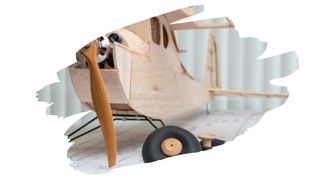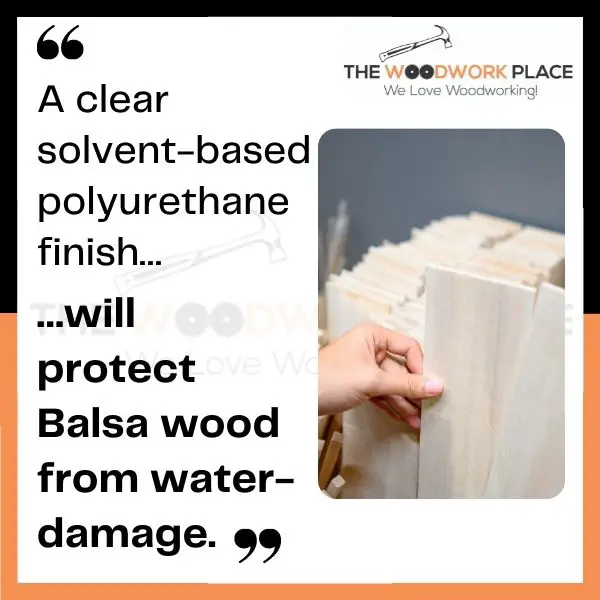Sealing Balsa wood is a great way to protect your model airplane, but some sealers can be absorbed by Balsa wood too quickly if you aren’t careful.
That’s because Balsa is a notoriously difficult wood to finish. And stains (plus other finishes) can leave a Balsa wood surface looking blotchy and uneven.
Yet, what about polyurethane? Can a polyurethane top coat protect your Balsa project?
Well, in this post, you will learn precisely why Balsa wood can be such a tricky timber to seal. You will also find out which particular type of polyurethane pairs well with Balsa’s porous surface.
And we reveal the very best polyurethane finishing product for Balsa wood crafts…

This post may contain affiliate links to products that we receive a commission for (at no additional cost to you). Learn more here.
Why Is Balsa Wood So Water Absorbent?
All porous wood will soak up water easily. It’s one of the reasons why wood is classed as being a hygroscopic material.
What that means is that wood is so absorbent, it can suck up the very moisture from the air around it. Which is why sealing wood is key to preventing water, rot and decay from setting in.
But, Balsa wood is a bit of a special case… even in the world of timber. Balsa is one of the lightest and least dense hardwoods around. And it’s lack of density makes it a dream to whittle and carve.
Related Post: Is Balsa Wood Good For Carving? (Explained) | TheWoodworkPlace.com
However, underneath the surface, this wood is more air than wood fiber. And all of those air filled voids mean that Balsa wood will soak up water like a super-sponge.
So, How Do You Seal Balsa Wood?
You can seal Balsa wood using a solvent based sealer (such as oil-based polyurethane).
As long as that sealing product is clear, you won’t have to worry about it leaving behind a blotchy looking finish. In fact, this is something we cover more in depth here on The Woodwork Place in our post: Can You Stain Balsa Wood? (Best Practice Revealed!).
But, make sure you use a solvent-based sealer product, and not a water-based one. Even a thin coating of water-based sealant is going to get soaked up by Balsa wood much too quickly for it to set properly.
Can You Put A Polyurethane Finish On Balsa Wood?
A water-resistant coat of solvent-based polyurethane will work great on Balsa wood. But, if you’re sealing a Balsa wood model airplane, you need to keep that poly coat as light as possible.
So, to prevent polyurethane from weighing down your aircraft, use a polyurethane spray.
Related Post: What Is The Difference Between Lacquer and Polyurethane? | TheWoodworkPlace.com
Using a polyurethane spray will keep the application of this finish as featherlight as possible. Also, by applying polyurethane as a thin spray, you can prevent Balsa wood from warping.
But, Doesn’t Solvent-Based Polyurethane Tend To Yellow?
Yes, it’s true. Yellowing finishes are pretty common among polyurethane products from the cheap end of the market.
However, high quality polyurethane products won’t have this discoloration issue.

And What Is The Best Polyurethane Spray Finish For Balsa Wood?
By far, the best clear polyurethane spray you can get your hands on is Krylon’s Clear Polyurethane Gloss Finish.
This clear coating finish doesn’t yellow with age, it takes mere minutes to dry, and it will safeguard Balsa wood from water damage. It’s been specially formulated to be used to seal everything from art, to photos, to (most importantly) your model crafts.
Which makes Krylon’s Clear Polyurethane Gloss Finish ideal for protecting sealing Balsa wood.
You can find the latest prices for this solvent-based polyurethane spray over on Amazon.
To Sum Up, Here Are The 3 Key Takeaways From This Post…
1). Balsa wood is super absorbent. So, it needs a sealing finish to prevent moisture from soaking into it.
2). A clear solvent-based polyurethane finish will protect Balsa wood from water-damage.
3). Use a polyurethane spray to apply this finish onto Balsa wood. This will keep the application of polyurethane as thin and as light as possible.
